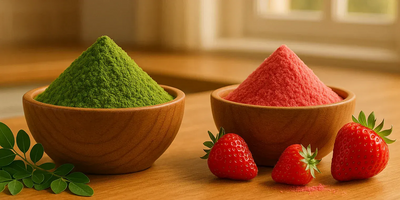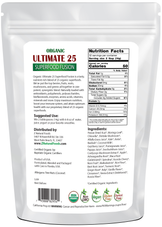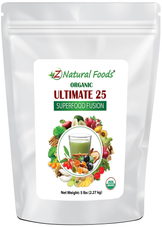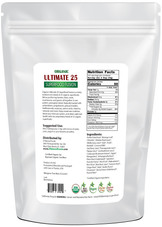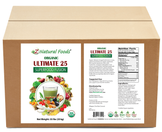Description
Description
Here at Z Natural Foods, we are always excited to bring you traditional foods from around the globe in their most versatile forms to help you achieve your nourishment and wellness goals.
Another year has passed, and we are proud that 2024 has been an exciting year for Z Natural Foods.
This year, we came out with some great-tasting, highly nourishing, functional food formulas and a healthier version of some classical / seasonal favorites like our:
We also provided you with some of the best and most comprehensive educational material on the internet that offers valuable information and real resolutions to your wellness concerns. We are so committed to educating you that we do something you rarely see in today's world; we also discuss herbs and foods that we don’t even sell.
7 Principles to Focus on to Achieve Your Food and Wellness Goals in 2025
Today, we will do a year-in-review and discuss our top seven principles you should focus on to achieve your food and wellness goals for 2025 and beyond.
We believe that long-term changes lead to long-term success.
1) Stick with the principles of the Mediterranean lifestyle
If you have read the many articles we have created this year discussing the Mediterranean lifestyle in-depth and compared it to some of the most popular fad diets, then you are incredibly well-educated about its value to your health and longevity. If you have not done so, we are sorry you missed out on all the fantastic information. However, have no fear because here is a summary of the vital principles that this lifestyle brings to the table.
But before we proceed, let’s do a quick review regarding the distinction between diet and lifestyle.
-
Lifestyle factors are the most accurate indicator of overall health success.
-
Diets don’t prioritize all the essential factors like food quality to achieve health and weight modification goals.
-
Diets often lack proof of long-term success in maintaining a healthy body weight and improving health markers. Therefore, It's important to note that short-term fad diets never contribute to better health.
-
Being compliant and consistent with the lifestyle of your choice always gets you to the winner's podium.
Next, here are a few critical elements that create the success of a well-maintained lifestyle.
-
Unwavering commitment to the quality and freshness of the ingredients.
-
Balancing work and leisure time, incorporating lifestyle habits like going home for lunch, taking a siesta, and engaging in regular physical activity that challenges you (mentally and physically) is equally essential. This balance gives us a sense of control over our health and well-being.
-
Dedication to the above principles ensures you always consume the best, most nutritious foods and faithfully live this lifestyle, providing balance and reassurance in your health choices.
Keep in mind that all of the above elements are critical. You can’t just choose which ones you want to do and ignore the others. They are all equally important. If you pick to do one out of four, then only expect 25% success. If you want 100% on your results, you must put in 100% effort.
The Mediterranean lifestyle is the most intensely researched and proven for supporting healthy body weight and improving risk factors like inflammation across various conditions. Both long and short-term studies prove this point.
A study titled Adherence to the Mediterranean Diet and Inflammatory Markers, which looked at how long-term compliance to this lifestyle affected markers of inflammation, stated the following:
-
Adherence to the Mediterranean diet in adolescent males was 51.3% and 45.7% in adults, whereas in females, it was 53.1% and 44.3%, respectively.
-
In males, higher adherence to the Mediterranean diet was associated with higher levels of adiponectin and lower levels of leptin, tumor necrosis factor-alpha (TNF-α), plasminogen activator inhibitor 1 (PAI-1), and high-sensitivity C-reactive protein (hs-CRP) in adults but not in young subjects. In females, higher adherence was associated with lower leptin levels in the young group, PAI-1 in adults, and hs-CRP in both groups.
-
With increasing age in both sexes, metabolic syndrome increases, but adherence to the Mediterranean diet decreases.
-
The people who experienced the most significant rise in polyphenol levels were shown to have significantly lower blood pressure and increased levels of beneficial HDL cholesterol compared to those with the lowest polyphenol evaluations.
Therefore, it was concluded that “low adherence to the Mediterranean dietary pattern (MDP) is directly associated with a worse profile of plasmatic inflammation markers.”
This conclusion, a result of rigorous scientific research, provides a solid foundation for the health benefits of the Mediterranean lifestyle. This scientific basis makes it a reliable and practical choice for health-conscious individuals, instilling confidence in its effectiveness.
2) Keep the whole foods and ditch the HIGHLY processed ones
It is essential to understand that how one defines the term processed (especially when discussing food) is all relative. Yes, fresh, unprocessed food should be the primary bulk of your food choices.
However, the simple acts of chopping, blending, juicing, drying, and especially cooking your food are forms of processing, sometimes denaturing.
For example, a protein denatured through cooking with heat or some other process is not bad. While the heat used to cook that protein may have changed its structural integrity, it still has excellent nutritional value and contains all the amino acids to create a complete protein. Furthermore, studies have shown that cooking tomatoes releases some of the potent nourishing compounds found in them. Therefore, we need to be careful about how we define the term processed.
The following characteristics are found in foods and a nourishing lifestyle that profoundly affect overall well-being:
-
Polyphenolic compounds are found in berries, tea, honey, herbs, spices, olive oil, and coffee.
-
A wide range of nourishing fats, both saturated and unsaturated
-
High-quality, locally raised, and produced protein sources
-
Tradition, quality, and the focus on high-quality ingredients
Truly processed foods are void of all of the above nourishing characteristics.
A critical point to understand regarding the MEDlifestyle is that quality ingredients and tradition are never compromised. For example, the following was stated in a comparative study looking at the effects of cooking with olive versus sunflower oil on the antioxidant activity of tomatoes:
-
Consumption of tomato products with olive oil significantly raised the plasma antioxidant activity (FRAP) from 930 +/- 150 to 1118 +/- 184 micromol/l, p <.01), but no effect was observed when the sunflower oil was used.
-
The change (supplementation minus start values) in FRAP following the consumption of tomato products with oil was significantly higher for olive oil (190 +/- 101) than for sunflower oil (-9.6 +/- 99, p <. 005).
Therefore, it was concluded that “the study results show that consumption of tomato products with olive oil but not with sunflower oil improves the antioxidant activity of the plasma.”
Often overlooked by every lifestyle is spending time with loved ones, building a close-knit community, and doing daily physical activity, which is considered second to none when considering the fantastic results of the MED lifestyle.
In a world-famous 80-year Harvard study about the importance of human connection and health, it was concluded that those who fared best were the ones who leaned on relationships with friends, family, and community.
3) Learn to adapt
Let’s face it: we live in times of high stress, and no more extraordinary aspect of our lifestyle has the ability to create havoc in our bodies. In many previous articles, we have discussed the value of adaptogenic herbs in depth.
In those articles, we looked at the three essential components defining an adaptogen. Adaptogens are classified as management and supportive herbs and fungi because the benefits are widespread through nonspecific physiological responses.
Adaptogens must:
1. Be nontoxic at clinical dosage
2. Increase the resistance of the hormonal and immune systems to all kinds of stressors through a nonspecific physiological response.
3. Normalize body function no matter how external stressors have altered them.
Then, we discussed that for an adaptogen to do its job, it must work through one or both of the body’s master control systems.
-
The HPA Axis (Hypothalamic-Pituitary-Adrenal Axis) is a complex system of neuroendocrine pathways and feedback loops that maintain and support homeostasis in response to chronic stress. The HPA axis interfaces the endocrine, nervous, immune, digestive, reproductive, and cardio systems.
-
The SAS (Sympatho Adrenal system, aka fight or flight) is a complex system that connects the sympathetic nervous system to the adrenal medulla. In simple terms, it is our fight-or-flight response. A triggered response floods our system with adrenalin and releases hormones epinephrine and norepinephrine from the adrenal medulla. This response increases blood pressure, blood sugar, and heart rate and suppresses digestion. This releasing of hormones and redistribution of blood allows the mind and body to respond and survive.
However, adaptogens are NOT a one-size-fits-all concept. It is essential to look at the individual, not the condition. Not every adaptogen is suitable for everyone. Like all other plant medicines, individual adaptogens have their unique qualities.
4) Nourish your foundation
Taking care of your skin, hair, nails, and joints is essential to enjoy a long, vibrant, and active lifestyle. In 2024, we did various articles discussing the nourishing benefits of collagen to support the above foundational aspects. However, bone broth is an outstanding food source of collagen and much more.
Bone broth is a nourishing and healing food made from a combination of bones like the humerus, spine, pelvic girdle, scapula, and sternum with parts rich in gelatin, like feet. While not a great source of quantitative amounts of protein, it is a quality source of amino acids used explicitly for potentially restoring good health. Bone broth is one of the most traditional foods in every culture. It is used to nourish and heal what ails you, and some traditionalists believe it could be one of the most nourishing foods on earth.
Bones, marrow, and connective tissue not only contain all the necessary materials needed to keep the structural foundation of our body strong and healthy, but they also yield a broad spectrum of essential vitamins and minerals when sourced adequately and appropriately prepared.
Bones contain calcium, phosphorus, magnesium, and potassium. The connective tissue material found in feet is rich in the building blocks for joint health, like glucosamine and chondroitin. Unlike taking those compounds in supplement form, this is a direct usable source. Bone marrow (the spongy and dense tissue that fills the inside of bones) is a quantitative source of vitamins A, B2, and B12, essential fatty acids, calcium, iron, selenium, and zinc. But beyond these tremendous components, bone marrow also contains unique cofactors that may support deep nourishment beyond the basics.
One of the missing links that are often overlooked when supporting healthy collagen levels is foods with high vitamin C levels. There is a clear connection between vitamin C and its effect on collagen synthesis. Without vitamin C, the body can’t form collagen. Simply, it acts as a glue to bind collagen fibers together.
In a preliminary in vitro study looking at the effects of vitamin C on collagen synthesis, it was discovered that; “vitamin C plays a crucial role in the maintenance of a normal mature collagen network in humans by preventing the auto inactivation of two key enzymes in collagen biosynthesis. It was also shown that vitamin C induced a dose-dependent increase in type I collagen deposits by normal human fibroblasts.
The following information was found in a systematic review performed with the inclusion criteria of animal and human studies on vitamin C supplementation after a musculoskeletal injury specific to collagen cross-linking, collagen synthesis, and biologic healing of the bone, ligament, and tendon.
-
Two preclinical studies evaluating fracture healing reported accelerated bone healing in the vitamin C group compared with the control group.
-
Two preclinical studies on tendon healing reported a significant increase in type I collagen fibers and scar tissue formation with the vitamin C group.
Therefore, it was concluded that the preclinical studies showed that vitamin C has the potential to accelerate bone healing, increase type I collagen synthesis, and reduce oxidative stress parameters.
5) Nourish your brain and nervous system
With depression, anxiety, stress, and the constant feeling of being overwhelmed at all-time highs, the need to nourish and support your brain and nervous system should be one of your goals for 2025.
This component is also essential for our ability to adapt. The foundation for a healthy brain is consuming a wide array of nourishing fats. Fats constitute the most significant nutritional source of energy.
There are two primary types of fats: saturated and unsaturated.
Structurally, saturated fats have no double bonds, whereas unsaturated fats have one or more bonds.
-
A fat with one double bond is considered monounsaturated, whereas
if it has more than one, it is polyunsaturated.
-
Polyunsaturated fats are divided into two classes: omega-3 and omega-6 fatty acids. EPA and DHA are long-chain omega-3 polyunsaturated fatty acids abundant in fish and shellfish.
An important point to understand is that while specific foods may be higher in a particular type of fat, all whole foods contain a mixture of saturated, mono, and polyunsaturated fats.
Nuts and seeds are a significant player in our consumption of nourishing fats. Consuming a wide range of nuts and seeds (like flax, chia, walnuts, pistachios, and almonds) ensures you get a nourishing amount of whole-food polyunsaturated fatty acids, the most abundant one being omega-6 linoleic acid.
For example, around 12% of walnuts' and up to 50% of flax seeds' fatty acid profile comes from the Omega-3 fatty acid Alpha linoleic acid (ALA), making them a well-balanced fatty acid food. The Mediterranean lifestyle will provide you with a wide variety of fat sources from whole foods, such as lamb, olive oil, fresh fish, and nuts and seeds.
However, there is one kind of fat that also fuels the brain and provides a level of unique nourishment. Medium-chain triglycerides are uniquely processed in the body, making them easier to digest and metabolize.
-
MCT’s are more ketogenic than long-chain triglycerides
-
Easily digested, MCTs give your body plenty of readily available energy
In the past, MCTs were considered unhealthy due to their high saturated fat content.
However, it has been proven that MCTs are unlike any other fat on earth and have a high nutritional value. So, why is MCT fat different? Well, MCTs are unique fat molecules; this makes their fat different from most of the fats we consume.
While the MED lifestyle highlights potent herbs like Rosemary and Sage for their culinary, medicinal, and brain-nourishing qualities, nature provides an impressive lineup of foods, herbs, and mushrooms for this exact purpose. While there are many more to add, here is a startup list you may want to consider.
-
Bacopa
-
Gotu Kola
-
Blueberries
-
Cacao
-
Lions Mane Mushroom
6) Nourish the Inflammation response
In simple terms, the inflammatory response processes depend on the precise nature of the initial stimulus and its location in the body; however, they all share a common mechanism pattern.
-
Cell surface pattern receptors recognize detrimental stimuli
-
Inflammatory pathways are activated
-
Inflammatory markers are released
-
Inflammatory cells are recruited.
It is no secret that inflammation, or an unhealthy inflammation response, is considered the primary underlying cause of many ailments. Inflammation is the reaction of a part of the body to injury or infection, characterized by swelling, heat, redness, and pain.
The process includes increased blood flow with an influx of white blood cells and other chemical substances that facilitate healing.
A small amount of inflammation in response to an injury to tell when something is wrong so the body can do its job and fix it is normal and healthy. However, over time, repetitive bouts of low-grade inflammation (caused by poor eating and lifestyle habits) promote an overstimulation of the inflammatory response and lead to chronic systemic inflammation.
When we look at the food and herbs that traditionally best nourish a healthy inflammation response, most people think of ginger, whole turmeric, various versions of isolated extracts of curcumin, black seed oil, or bromelain from pineapple, all of which are excellent choices. However, modern medicine has not provided a healthy, long-term solution to chronic inflammation. What they have provided to us is short-term solutions with serious pitfalls. Make no mistake, these pharmaceuticals work; however, they come with significant risks. Understanding what anti-inflammatories are, what they do, and their potential pitfalls is essential.
Anti-inflammatories only work on one area of the inflammation cascade and often negatively disrupt the entire cascade. In a nutshell, nonsteroidal anti-inflammatories work by reducing prostaglandins called cyclooxygenases, otherwise known as COX.
There are two types of COX enzymes known as COX-1 and COX-2. Both produce these prostaglandins that activate platelets and protect the stomach lining. The job of nonsteroidal anti-inflammatories is to essentially block the COX enzymes and reduce the production of prostaglandins. For your reference, aspirin is a COX-1 inhibitor, and Celebrex (now known as celecoxib) and ibuprofen are COX-2 inhibitors. Here is a reference link from the Cleveland Clinic on Celecoxib.
Prednisone (A steroid-based anti-inflammatory) works in a much different way to produce a similar result. According to the Mayo Clinic, “Corticosteroids mimic the effects of hormones your body produces naturally in your adrenal glands.” While corticosteroids have serious pitfalls (especially with high-dose and/or long-term use), they are also potent and effective compounds. The following was stated on GoodRX.com.
There’s no official definition for long-term use. However, over 30 days is generally considered long-term steroid use. Most often, oral corticosteroids are prescribed for roughly 1 to 2 weeks — and only for very severe symptoms. However, for certain chronic health conditions, such as rheumatoid arthritis, corticosteroids may be necessary for months or even years. The longer you take corticosteroids, the more likely you’ll have side effects. Oral corticosteroids like prednisone are much more likely than local corticosteroids to cause these side effects.
7) Nourish your Immune System for your individual constitution
Last year, we wrote many articles about the nourishing qualities of foods that support a healthy immune system response. However, not all foods and herbs support a healthy immune system response in the same way, as each has unique qualities. Therefore, picking the right foods and herbs for your needs and using the proper part of the plant that will support the response you want is essential.
The herb echinacea is an excellent example of the best ways to use the different parts of the plant when looking to support the activation of specific pathways. The root is more concentrated in alkylamides, which may support a healthy inflammation response and is best for the acute stages. It is often used in high amounts for short durations. The ariel (above ground) portion is more concentrated in lipoproteins and polysaccharides, which are known to stimulate and strengthen our constitutional response when taken in small quantities over an extended period. Furthermore, depending on the time of year or pathogen you may be dealing with are profound aspects to which herbs and foods you apply to a situation.
However, one of the most underrated aspects of nourishing the immune system is to consider what is right for you based on the energy of the herb or food substance. Chinese medicine states there are no bad foods, just the right foods at the right time.
Foods and herbs can have warming, cooling, drying, or moistening qualities, and picking what is appropriate for you at that time is always the best method. Therefore, attempting to use the same program yearly for cold and flu or allergy season may not always be effective as it does not look at your specific situation, which may present differently from last year.
Here is a list of immune-nourishing foods and herbs with a wide array of uses to sink your teeth into:
In conclusion, we understand that everyone's lifestyle is different based on many factors, and we are here to help you overcome those bumps in the road that may throw you off track.
Because we firmly believe that long-term changes lead to long-term success, following our top seven principles will not only provide you with the nourishment you need for a strong and healthy 2025 but for years to come.

